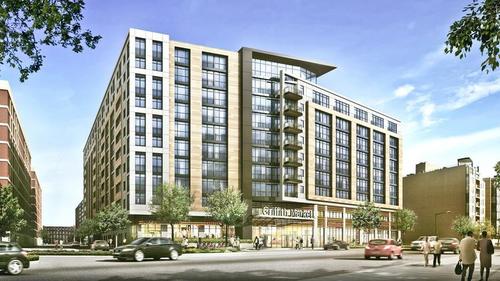The controversy over affordable housing on Florida Avenue, explained
A new development in Shaw will bring a Whole Foods and 352 apartments, 107 price below market rate. But there’s controversy over whether the DC government should have sold the site for its full value of $27 million, for $5 million, or $400,000.
There are two fundamental questions. First, is it worth paying to locate subsidized affordable housing in wealthier neighborhoods, where the opportunity cost is higher? Second, did the Bowser administration negotiate a bad deal for what it got?

Housing deal image from Shutterstock.
What’s this deal?
This building will sit on publicly-owned land at 965 Florida Avenue, where 9th, T W Street, Sherman Avenue, and Florida Avenue come together. In 2013, after a bidding process, DC’s Deputy Mayor for Planning and Economic Development (DMPED) chose MRP Realty to develop the site.
There’s been a long-running debate in DC about whether, when selling a piece of public land, the city should strive to get as much cash as possible, or include more below-market housing. The DC Council passed a bill later that year, by Ward 5 councilmember Kenyan McDuffie, to require 20-30% of units in public land deals be affordable to people making 30-50% of the Area Median Income.
The city then renegotiated the 965 Florida arrangement to comply with this rule. Last week, the council approved the deal. The next step is for the developers to file a Planned Unit Development with the Zoning Commission with more details about the proposed building.
What did it cost?
Aaron Davis reported on the project in the Washington Post. According to documents he obtained, the property would be worth about $27.6 million if sold outright.
An appraiser concluded that with the below-market housing requirement, the property is still worth $5.9 million. In the deal, MRP is paying the District $400,000.
The eye-catching but confusing headline, “How D.C. turned $27 million into $400,000,” caused some people to confuse the two issues. One is whether it is worth about $20 million to get an affordability limit on 107 units. The other is whether the Bowser Administration blew the other $5 million.
Should “deeply affordable” housing be part of such deals?
Some people don’t agree with the McDuffie bill in the first place. There are those who think affordable housing shouldn’t be part of a deal at all. Others argue that it would be better to take the cash in the hot U Street/Shaw area and use it for affordable housing somewhere cheaper.
@alpert how many housing vouchers could $26 million fund, had the building been sold at market?
— Byron Tau (@ByronTau) September 26, 2015
The latter argument is actually the flip side of an issue Martin Austermuhle just reported on for WAMU: DC’s housing authority is selling off townhouses in now-hot markets like Columbia Heights for top dollar and using the money in its budget elsewhere. There was also a public land deal in the Mount Vernon Triangle (before the McDuffie bill passed) to put all required affordable housing in Anacostia instead.
On the one hand, you can buy more housing for the same money in a cheap area. On the other hand, residents in those areas already feel that lower-income housing is already too concentrated in their areas. Research has demonstrated that lower-income children who grow up in higher-income areas succeed more in life, so there’s some definite value in using resources to create mixed-income communities.
The recent HBO series Show Me a Hero depicted the political fight that ensued when a court required Yonkers, NY to put some public housing in fancier neighborhoods. The Housing Authority sales or the MVT land deal are perpetuating concentration, while 965 Florida deal is the direct result of efforts to spread housing around.

Money floating away image from Shutterstock.
Did the Bowser administration get a bad deal?
Even with the required below-market housing, the appraiser estimated DC should get $5.9 million instead of $400,000. In a committee report on the land deal, DC Council Chairman Phil Mendelson said that DMPED’s “record is disappointing” when it comes to being “a shrewd negotiator on behalf of the city.”
Mendelson notes that DMPED blocked the council from getting another appraisal, hasn’t ensured that the affordable housing would even last in perpetuity (which reportedly the developer was willing to accept), and didn’t arrange for DC to get more money if the developer can build a larger building than in the initial bid (which, Mendelson’s report says, the developer was also willing to accept).
This reflects many of the concerns people have raised about a Wizards/Mystics facility at St. Elizabeth’s. It actually doesn’t seem like such a bad idea to put a sports complex here if that’s the best way to jump-start development in the area. DC was already going to spend money on St. Elizabeth’s, and the rest of the money will come from the sports and convention authority, which only will use its money for things that promote sports and conventions.
The bigger question, and one the Post editorial board focused on, is whether the deal really adds up. A wealthy sports team owner is getting something of value, though so is the city, and the debate mainly centers on how much value each party gains.
Was St. Elizabeth’s really stalled without this deal? Will it bring the promised benefits? Maybe so. And even if we’re unsure, maybe Congress Heights deserves a gamble.
And it’s easy to nitpick any deal. Sometimes in a business transaction, you have to give a little more than you want to make it work. Certainly when any homeowner does a renovation, for instance, some things cost a little more than planned. If every homeowner had a city full of people looking over his or her shoulder at every choice of tiles or lighting, it’d be easy to find flaws.
However, in those cases, and when a corporation negotiates a deal, it’s not public money. It’s easier for an economic development official, with the best of intentions, to give away a little more taxpayer funding when it’s the way to ensure a deal goes through. Maybe that’s worthwhile, since when it comes to a land development deal, there’s also a big cost to adding years more delay while the site is fallow and generating no tax revenue.
One other factor is what would happen with the extra money. Sometimes there are really worthwhile ways to spend it. But sometimes the alternative is a pile of other pork-barrel projects or tax cuts that won’t stimulate economic growth. For all the criticism, some deserved and some not, of the price tag of the DC Streetcar, cutting it hasn’t led to an equivalent pile of money ready for a different transportation project that critics liked better.
There’s a balance, and residents understandably would like to have confidence that the city is negotiating a good deal while also needing to have a little patience that every deal can’t be perfect.

